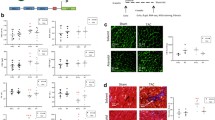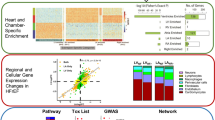Abstract
Nuclear factor-κB (NF-κB) is a ubiquitous transcription factor that has been indicated to play a causal role for many pathological states. Heart failure is a major cause of morbidity all over the world. In this study, we examined the role of NF-κB in failing (F) human hearts and nonfailing (NF) controls. Our data showed that an enhanced activation of this nuclear factor occurs in the F hearts along with its components, like I-κB kinase (IKK)β and IκBα, both at transcript and translational levels. To obtain a profile of NF-κB-targeted gene expression in F hearts, we profiled, for the first time, the expression analysis of NF-κB-linked gene using a TranSignal human NF-κB-targeted gene array. Our data suggest that more than 50 genes were consistently upregulated in F hearts more than 1.5-fold (vs NF hearts, p<0.001). Our studies demonstrated that NF-κB is specifically and significantly activated via IKKβ in F hearts. The most intriguing aspects of our studies are molecular profiles of NF-κB-linked or targeted gene expression in F hearts. Our data suggest that the regulation and control of NF-κB activation is, therefore, a powerful therapeutic strategy for delaying or attenuating such deadly disease.






Similar content being viewed by others
Change history
27 March 2020
The Editor-in-Chief has retracted this article [1] because a number of lanes in Figs. 3, 4 and 6 of this article are duplicated.
References
Maron BJ, Gardin JM, Flack JM, Gidding SS, Kurosaki TT, Bild DE (1995) Prevalence of hypertrophic cardiomyopathy in a general population of young adults. Echocardiographic analysis of 4111 subjects in the CARDIA Study. Coronary artery risk development in (young) adults. Circulation 92:785–789
Maron BJ (1997) Hypertrophic cardiomyopathy. Lancet 350:127–133
Sabbah HN, Sharov VG, Lesch M, Goldstein S (1995) Progression of heart failure: a role for interstitial fibrosis. Mol Cell Biochem 147:29–34
Manabe I, Shindo T, Nagai R (2002) Gene expression in fibroblasts and fibrosis: involvement in cardiac hypertrophy. Circ Res 91:1103–1113
Chen F, Castranova V, Shi X, Demers LMA (1999) New insights into the role of nuclear factor-κB, a ubiquitous transcription factor in the initiation of diseases. Clin Chem 45:7–17
Barnes PJ, Karin M (1997) Nuclear factor-kappaB: a pivotal transcription factor in chronic inflammatory diseases. N Engl J Med 336:1066–1071
Ghosh S, May MJ, Kopp EB (1998) NF-kappa B and Rel proteins: evolutionarily conserved mediators of immune responses. Annu Rev Immunol 16:225–260
Baeuerle PA, Henkel T (1994) Function and activation of NF-κB in the immune system. Annu Rev Immunol 12:141–179
Valen G, Yan ZQ, Hansson GK (2001) Nuclear factor kappa-B and the heart. J Am Coll Cardiol 38:307–314
Sen R, Baltimore D (1986) Multiple nuclear factors interact with the immunoglobulin enhancer sequences. Cell 46:705–716
Thurberg BL, Collins T (1998) The nuclear factor-κ B/inhibitor of κB autoregulatory system and atherosclerosis. Curr Opin Lipidol 9:387–396
Baldwin AS Jr (1996) The NF-κB and I-κB proteins: new discoveries and insights. Annu Rev Immunol 14:649–681
Chen ZJ, Parent L, Maniatis T (1996) Site-specific phosphorylation of I κBα by a novel ubiquitination-dependent protein kinase activity. Cell 84:853–862
DiDonato JA, Hayakawa M, Rothwarf DM, Zandi E, Karin M (1997) A cytokine-responsive IκB kinase that activates the transcription factor NF-κB. Nature 388:548–554
Zandi E, Chen Y, Karin M (1998) Direct phosphorylation of IκB by IKKα and IKKβ: discrimination between free and NF-κB-bound substrate. Science 281:1360–1363
Zandi E, Rothwarf DM, Delhase M, Hayakawa M, Karin M (1997) The IκB kinase complex (IKK) contains two kinase subunits, IKKα and IKKβ, necessary for IκB phosphorylation and NF-κB activation. Cell 91:243–252
Yamaoka S, Courtois G, Bessia C, Whiteside ST, Weil R, Agou F, Kirk HE, Kay RJ, Israel A (1998) Complementation cloning of NEMO, a component of the IκB kinase complex essential for NF-κB activation. Cell 93:1231–1240
Rothwarf DM, Zandi E, Natoli G, Karin M (1998) IKK-γ is an essential regulatory subunit of the IκB kinase complex. Nature 395:297–300
Mercurio F, Murray BW, Shevchenko A, Bennett BL, Young DB, Li JW, Pascual G, Motiwala A, Zhu H, Mann M, Manning AM (1999) IκB kinase (IKK)-associated protein 1, a common component of the heterogeneous IKK complex. Mol Cell Biol 19:1526–1538
Li Q, Lu Q, Hwang JY, Buscher D, Lee KF, Izpisua-Belmonte JC, Verma IM (1999) IKK1-deficient mice exhibit abnormal development of skin and skeleton. Genes Dev 13:1322–1328
Li Q, Van Antwerp D, Mercurio F, Lee KF, Verma IM (1999) Severe liver degeneration in mice lacking the IkappaB kinase 2 gene. Science 284:321–325
Li ZW, Chu W, Hu Y, Delhase M, Deerinck T, Ellisman M, Johnson R, Karin M (1999) The IKKbeta subunit of IkappaB kinase (IKK) is essential for nuclear factor kappaB activation and prevention of apoptosis. J Exp Med 189:1839–1845
Xuan YT, Tang XL, Banerjee S, Takano H, Li RC, Han H, Qiu Y, Li JJ, Bolli R (1999) Nuclear factor-kappaB plays an essential role in the late phase of ischemic preconditioning in conscious rabbits. Circ Res 84:1095–1109
Maulik N, Sato M, Price BD, Das DK (1998) An essential role of NFkappaB in tyrosine kinase signaling of p38 MAP kinase regulation of myocardial adaptation to ischemia. FEBS Lett 429:365–369
Wong SC, Fukuchi M, Melnyk P, Rodger I, Giaid A (1998) Induction of cyclooxygenase-2 and activation of nuclear factor-kappaB in myocardium of patients with congestive heart failure. Circulation 98:100–103
Ritchie ME (1998) Nuclear factor-kappaB is selectively and markedly activated in humans with unstable angina pectoris. Circulation 98:1707–1713
Selzman CH, Shames BD, Reznikov LL, Miller SA, Meng X, Barton HA, Werman A, Harken AH, Dinarello CA, Banerjee A (1999) Liposomal delivery of purified inhibitory-kappaBalpha inhibits tumor necrosis factor-alpha-induced human vascular smooth muscle proliferation. Circ Res 84:867–875
Gupta S, Purcell NH, Lin A, Sen S (2002) Activation of nuclear factor-kappaB is necessary for myotrophin-induced cardiac hypertrophy. J Cell Biol 159:1019–1028
Purcell NH, Tang G, Yu C, Mercurio F, DiDonato JA, Lin A (2001) Activation of NF-kappa B is required for hypertrophic growth of primary rat neonatal ventricular cardiomyocytes. Proc Natl Acad Sci U S A 98:6668–6673
Sprung J, Schuetz SM, Stewart RW, Moravec CS (1998) Effects of ketamine on the contractility of failing and nonfailing human heart muscles in vitro. Anesthesiology 88:1202–1210
Dignam JD, Martin PL, Shastry BS, Roeder RG (1983) Eukaryotic gene transcription with purified components. Methods Enzymol 101:582–598
Chomczynski P, Sacchi N (1987) Single-step method of RNA isolation by acid guanidinium thiocyanate-phenol-chloroform extraction. Anal Biochem 162:156–159
Li C, Browder W, Kao RL (1999) Early activation of transcription factor NF-kappaB during ischemia in perfused rat heart. Am J Physiol 276:H543–H552
Marian AJ, Roberts R (2001) The molecular genetic basis for hypertrophic cardiomyopathy. J Mol Cell Cardiol 33:655–670
Maron BJ, Roberts WC (1979) Quantitative analysis of cardiac muscle cell disorganization in the ventricular septum of patients with hypertrophic cardiomyopathy. Circulation 59:689–706
Spirito P, Bellone P, Harris KM, Bernabo P, Bruzzi P, Maron BJ (2000) Magnitude of left ventricular hypertrophy and risk of sudden death in hypertrophic cardiomyopathy. N Engl J Med 342:1778–1785
Cohn JN, Ferrari R, Sharpe N (2000) Cardiac remodeling—concepts and clinical implications: a consensus paper from an international forum on cardiac remodeling. Behalf of an International Forum on Cardiac Remodeling. J Am Coll Cardiol 35:569–582
Baeuerle PA, Baltimore D (1996) NF-kappa B: ten years after. Cell 87:13–20
Meldrum DR, Shenkar R, Sheridan BC, Cain BS, Abraham E, Harken AH (1997) Hemorrhage activates myocardial NFkappaB and increases TNF-alpha in the heart. J Mol Cell Cardiol 29:2849–2854
Helenius M, Hanninen M, Lehtinen SK, Salminen A (1996) Aging-induced up-regulation of nuclear binding activities of oxidative stress responsive NF-kB transcription factor in mouse cardiac muscle. J Mol Cell Cardiol 28:487–498
Cook SA, Novikov MS, Ahn Y, Matsui T, Rosenzweig A (2003) A20 is dynamically regulated in the heart and inhibits the hypertrophic response. Circulation 108:664–667
Le Bail O, Schmidt-Ullrich R, Israel A (1993) Promoter analysis of the gene encoding the I kappa B-alpha/MAD3 inhibitor of NF-kappa B: positive regulation by members of the rel/NF-kappa B family. EMBO J 12:5043–5049
Shames BD, Meldrum DR, Selzman CH, Pulido EJ, Cain BS, Banerjee A, Harken AH, Meng X (1998) Increased levels of myocardial IkappaB-alpha protein promote tolerance to endotoxin. Am J Physiol 275:H1084–H1091
Regula KM, Ens K, Kirshenbaum LA (2002) IKK beta is required for Bcl-2-mediated NF-kappa B activation in ventricular myocytes. J Biol Chem 277:38676–38682
Gupta S, Young D, Sen S (2005) Inhibition of NF-{kappa}B induces regression of cardiac hypertrophy, independent of blood pressure control, in spontaneously hypertensive rats. Am J Physiol Heart Circ Physiol 289:H20–H29
Connor EM, Eppihimer MJ, Morise Z, Granger DN, Grisham MB (1999) Expression of mucosal addressin cell adhesion molecule-1 (MAdCAM-1) in acute and chronic inflammation. J Leukoc Biol 65:349–355
Iwai-Kanai E, Hasegawa K, Sawamura T, Fujita M, Yanazume T, Toyokuni S, Adachi S, Kihara Y, Sasayama S (2001) Activation of lectin-like oxidized low-density lipoprotein receptor-1 induces apoptosis in cultured neonatal rat cardiac myocytes. Circulation 104:2948–2954
Paolisso G, Gambardella A, Galzerano D, D’Amore A, Rubino P, Verza M, Teasuro P, Varricchio M, D’Onofrio F (1994) Total-body and myocardial substrate oxidation in congestive heart failure. Metabolism 43:174–179
Vulapalli SR, Chen Z, Chua BH, Wang T, Liang CS (2002) Cardioselective overexpression of HO-1 prevents I/R-induced cardiac dysfunction and apoptosis. Am J Physiol Heart Circ Physiol 283:H688–H694
Chen YH, Yet SF, Perrella MA (2003) Role of heme oxygenase-1 in the regulation of blood pressure and cardiac function. Exp Biol Med 228:447–453
Raju VS, Imai N, Liang CS (1999) Chamber-specific regulation of heme oxygenase-1 (heat shock protein 32) in right-sided congestive heart failure. J Mol Cell Cardiol 31:1581–1589
Siebenlist U, Franzoso G, Brown K (1994) Structure, regulation and function of NF-κB. Annu Rev Cell Biol 10:405–455
Purcell NH, Molkentin JD (2003) Is nuclear factor kappaB an attractive therapeutic target for treating cardiac hypertrophy? Circulation 108:638–640
Acknowledgements
The authors acknowledge the assistance of the cardiac transplantation team, pathology residents, and Dr. Normal Ratliff for help in procuring failing human heart tissues for research. The authors sincerely acknowledge Dr. Christine S. Moravec and Wendy Sweet, Department of Cardiovascular Medicine, Cleveland Clinic Foundation, for providing us the failing and nonfailing explanted human heart samples. The authors thank Life-Banc of Northeastern Ohio for nonfailing human heart tissue. The study was supported in part by National Institutes of Health grants HL RO1 47794 to Dr. S. Sen. The authors also acknowledge Mr. Dave Young for expert technical assistance, Dr. A. Braiser for IκBα cDNA, Dr. S. Ghosh for p65 cDNA, the statistical assistance of Geri Locker, Dept. of Biostatistics and Epidemiology, and the expert editorial assistance of Christine Kassuba and Jane Rein.
Author information
Authors and Affiliations
Corresponding author
Additional information
The Editor-in-Chief has retracted this article because a number of lanes in Figures 3, 4 and 6 of this article are duplicated. The data are therefore unreliable. Sudhiranjan Gupta does not agree to this retraction. We have not been able to contact author Subha Sen about this retraction.
Electronic Supplementary Material
About this article
Cite this article
Gupta, S., Sen, S. RETRACTED ARTICLE: Role of the NF-κB signaling cascade and NF-κB-targeted genes in failing human hearts. J Mol Med 83, 993–1004 (2005). https://doi.org/10.1007/s00109-005-0691-z
Received:
Accepted:
Published:
Issue Date:
DOI: https://doi.org/10.1007/s00109-005-0691-z




